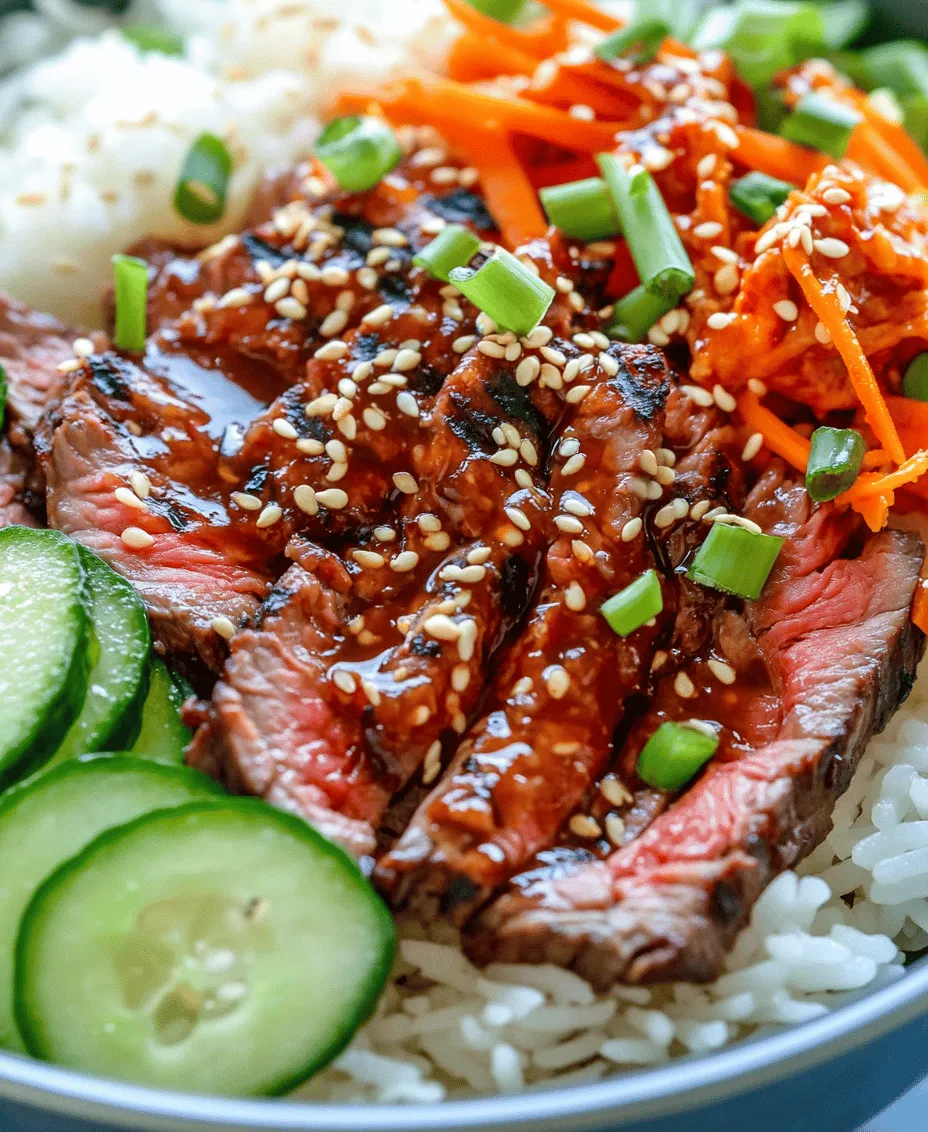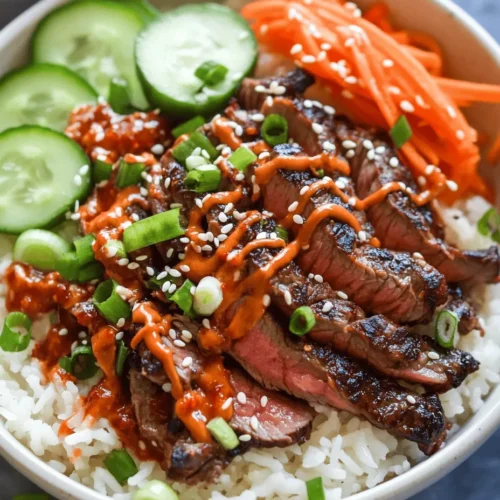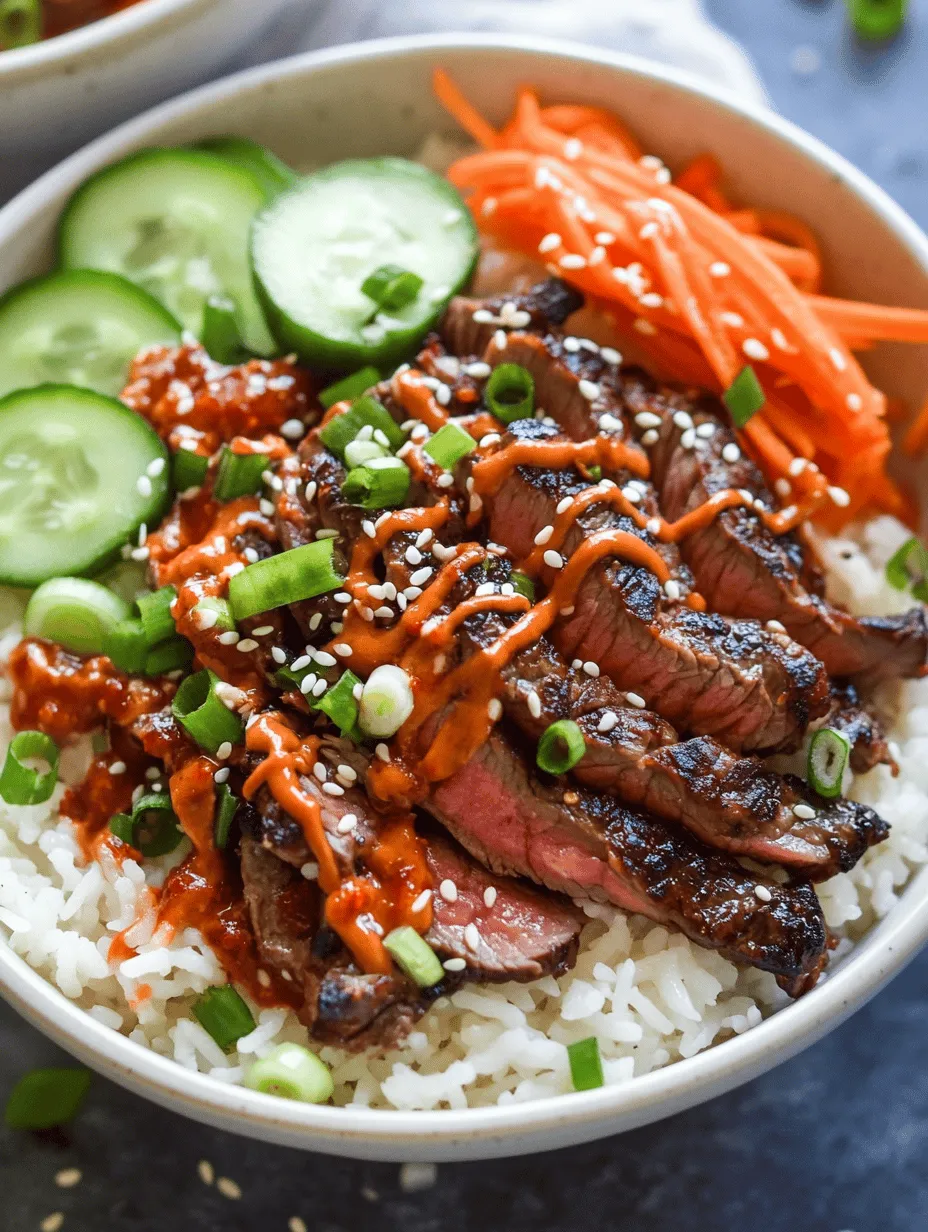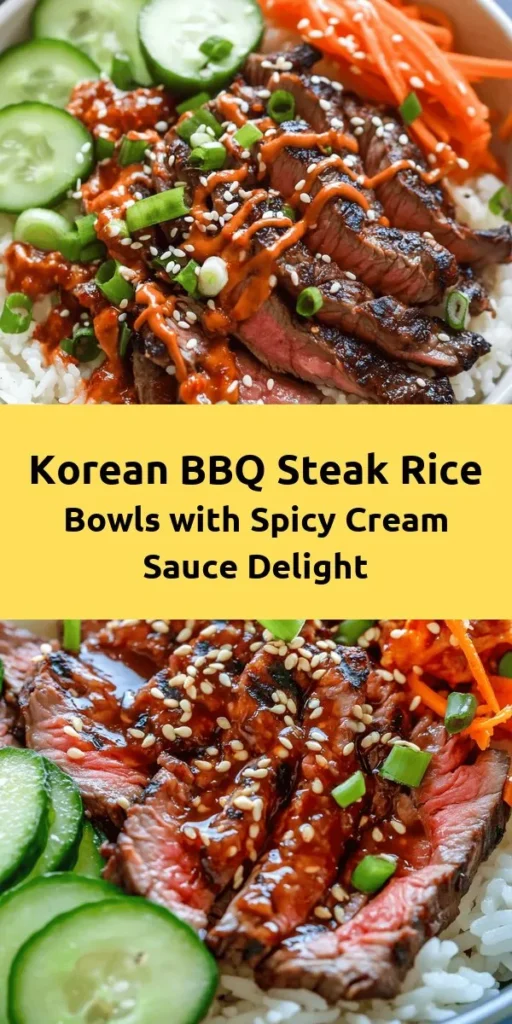Introduction
Korean cuisine has captivated food lovers around the world, gaining immense popularity for its bold flavors, vibrant colors, and unique textures. From the sizzling sounds of grilled meats to the intricate balance of sweet, savory, and spicy notes, Korean food offers a culinary experience that is both satisfying and memorable. Among the many delightful dishes, Korean BBQ stands out as a favorite, epitomizing the communal spirit of dining and the art of grilling. One dish that encapsulates this essence beautifully is the Korean BBQ Steak Rice Bowl, a fusion of savory grilled steak served over a bed of fluffy rice, topped with fresh vegetables and a tantalizing spicy cream sauce.
This recipe for Korean BBQ Steak Rice Bowls invites you to bring the flavors of Korean BBQ into your home kitchen. It combines the rich, smoky taste of marinated flank steak with the creamy heat of a spicy sauce, creating a dish that is not only delicious but also visually appealing. The satisfaction of preparing a homemade Korean meal cannot be overstated, as it allows you to explore the intricate flavors of this beloved cuisine while creating a nourishing meal for family and friends.
Understanding Korean BBQ
To truly appreciate Korean BBQ, it’s essential to delve into its historical context and cultural significance. Originating from ancient times, Korean BBQ has evolved into a social dining experience that emphasizes communal cooking and shared enjoyment. Traditionally, diners grill their own meats at the table, creating a warm, interactive atmosphere that fosters connection and conversation. The act of grilling meat over an open flame is not just a cooking technique; it symbolizes the Korean approach to food as a communal and celebratory event.
Key ingredients define Korean BBQ, elevating the experience with rich flavors and aromatic profiles. The cornerstone of any Korean BBQ dish is the marinade, which typically features soy sauce, sesame oil, garlic, and ginger. These ingredients work harmoniously to tenderize the meat and infuse it with deep umami flavors. Additionally, gochujang, a fermented red chili paste, adds a distinctive heat and sweetness that is quintessential to Korean cuisine. The grilling technique, often done over charcoal or gas, imparts a smoky flavor that enhances the overall dish, making each bite a delightful explosion of taste.
Ingredients Breakdown
Core Ingredients for the Korean BBQ Steak
Flank Steak: The star of this recipe is the flank steak, known for its rich beef flavor and relatively lean texture. It is a popular choice for Korean BBQ due to its ability to absorb marinades and retain juiciness when cooked correctly. When choosing flank steak, look for cuts that are bright red with a good amount of marbling, as this will ensure tenderness and flavor. The best cooking methods for flank steak include grilling, broiling, or pan-searing, with a focus on achieving a perfect medium-rare doneness to maintain its juicy texture.
Marinade Components
The marinade for the flank steak is a harmonious blend of ingredients that create a complex flavor profile:
– Soy Sauce: This staple ingredient provides saltiness and depth, serving as the foundation of the marinade.
– Brown Sugar: The sweetness of brown sugar balances the salty soy sauce and helps caramelize the meat during cooking, resulting in a beautiful glaze.
– Sesame Oil: A drizzle of sesame oil adds a nutty aroma and richness that enhances the overall taste of the dish.
– Garlic and Ginger: Freshly minced garlic and ginger contribute a fragrant, aromatic quality that is characteristic of Korean flavors.
– Rice Vinegar: This ingredient introduces a subtle acidity that brightens the dish and tenderizes the meat.
– Gochujang: This fermented chili paste is a key player in Korean cooking, adding heat and a touch of sweetness that elevates the marinade.
– Sesame Seeds: Toasted sesame seeds can be sprinkled over the finished dish for added crunch and flavor.
Overview of the Spicy Cream Sauce
To complement the savory steak, this recipe features a spicy cream sauce that brings a delightful kick to each rice bowl. The components of the sauce include:
– Mayonnaise: The base of the sauce, providing creaminess and a smooth texture.
– Gochujang: A second dose of this spicy paste brings heat and depth to the sauce, creating a robust flavor balance.
– Lime Juice: Fresh lime juice adds acidity and brightness, cutting through the richness of the mayonnaise.
– Maple Syrup: This natural sweetener introduces a hint of sweetness that contrasts with the spiciness.
– Sriracha: For those who crave extra heat, sriracha can be added to amp up the spice level.
– Seasoning: A pinch of salt and pepper rounds off the flavor, ensuring that each bite is perfectly seasoned.
Rice Bowl Essentials
In Korean cuisine, rice is a fundamental component of the meal, serving as a neutral base that balances the bold flavors of the accompanying dishes. For this recipe, you can choose from various rice options, such as jasmine rice for a fragrant touch or brown rice for added nutrients and fiber. Whichever rice you select, ensure it is cooked to perfection, fluffy and tender, to create a satisfying backdrop for the steak and sauce.
Fresh vegetables also play a crucial role in enhancing the texture and flavor of the dish. Thinly sliced cucumbers and julienned carrots add a refreshing crunch, while optional kimchi brings a spicy, fermented element that is beloved in Korean cuisine. The combination of these ingredients creates a vibrant, colorful rice bowl that is as pleasing to the eye as it is to the palate.
Marinating the Steak
Marinating the flank steak is a vital step that enhances the flavor and tenderness of the meat. Here’s a step-by-step guide to ensure your steak is perfectly marinated:
1. Prepare the Marinade: In a mixing bowl, combine soy sauce, brown sugar, sesame oil, minced garlic, grated ginger, rice vinegar, gochujang, and sesame seeds. Whisk thoroughly until the sugar dissolves and all ingredients are well incorporated.
2. Select the Flank Steak: Choose a high-quality flank steak, ensuring it’s well-trimmed and free of excess fat. This will allow the marinade to penetrate the meat effectively.
3. Marinate the Steak: Place the flank steak in a large resealable plastic bag or a shallow dish. Pour the marinade over the steak, ensuring it is evenly coated. Seal the bag or cover the dish with plastic wrap.
4. Refrigerate: Allow the steak to marinate in the refrigerator for at least 30 minutes, although for optimal flavor, aim for 2-4 hours. If you have time, marinating overnight will yield even more flavorful results.
5. Remove and Prepare for Cooking: Before cooking, take the steak out of the refrigerator and let it sit at room temperature for about 15-20 minutes. This helps it cook evenly. Pat the steak dry with paper towels to promote better searing.
6. Cook the Steak: Preheat your grill, grill pan, or skillet over medium-high heat. Cook the marinated steak for about 4-6 minutes per side, depending on thickness, until it reaches an internal temperature of 130°F for medium-rare.
By properly marinating the flank steak, you set the stage for a delicious and tender result that will shine in your Korean BBQ Steak Rice Bowls.

Preparing the Spicy Cream Sauce
To create the perfect spicy cream sauce for your Korean BBQ Steak Rice Bowls, start by gathering your ingredients: mayonnaise, gochujang (Korean red chili paste), rice vinegar, a pinch of sugar, and minced garlic. This sauce not only adds a kick to the dish but also complements the savory flavors of the marinated steak beautifully.
1. Combine Ingredients: In a medium bowl, add ½ cup of mayonnaise, 2 tablespoons of gochujang, 1 tablespoon of rice vinegar, a teaspoon of sugar, and 1 clove of minced garlic.
2. Whisk Together: Using a whisk or a fork, mix the ingredients until smooth. The mayonnaise provides a creamy base, while the gochujang brings in heat and depth. The rice vinegar adds a tangy note, balancing out the richness of the mayonnaise.
3. Taste and Adjust: Before proceeding, taste the sauce. If you prefer more heat, add an extra teaspoon of gochujang. For a milder flavor, reduce the amount slightly. You can also adjust the sweetness by adding more sugar if desired.
4. Refrigerate: Once mixed, cover the sauce and refrigerate it for at least 30 minutes. This resting period allows the flavors to meld together, resulting in a more flavorful sauce.
The versatility of this sauce is remarkable; you can use it as a dip for vegetables, a dressing for salads, or even a condiment for sandwiches. It’s a great addition to your culinary repertoire and can be tailored to suit your spice tolerance.
Cooking the Steak
The star of the Korean BBQ Steak Rice Bowls is undoubtedly the steak, which should be tender, juicy, and packed with flavor. Whether you choose to grill or pan-sear, following some key techniques will ensure your steak is cooked to perfection.
1. Choose the Right Cut: Flank steak or sirloin is recommended for this recipe due to their rich flavor and tenderness. Make sure to slice against the grain for maximum tenderness.
2. Marinate the Steak: Prior to cooking, marinate the steak for at least 30 minutes (or up to overnight) in a mixture of soy sauce, sesame oil, garlic, and ginger. This enhances the flavor and tenderness of the meat.
3. Cooking Technique:
– Grilling: Preheat your grill to high heat. Remove the steak from the marinade and let any excess drip off. Place the steak on the grill, cooking for about 3-5 minutes per side for medium-rare, depending on thickness.
– Pan-Searing: Heat a cast-iron skillet or heavy-bottomed pan over medium-high heat until it’s hot. Add a tablespoon of oil, then place the steak in the skillet. Cook for approximately 4-6 minutes on each side for medium-rare.
4. Check Doneness: Use a meat thermometer to check the internal temperature. Aim for 130°F for medium-rare, 140°F for medium, and 150°F for medium-well.
5. Rest the Steak: Once cooked, remove the steak from the heat and let it rest for at least 5-10 minutes. This step is crucial as it allows the juices to redistribute within the meat, resulting in a more tender and juicy bite.
Assembling the Rice Bowls
Now that your spicy cream sauce and perfectly cooked steak are ready, it’s time to assemble your Korean BBQ Steak Rice Bowls. Here’s how to create a visually appealing and delicious dish:
1. Start with Rice: Begin by placing a generous scoop of cooked jasmine or short-grain rice at the bottom of each bowl. The rice acts as the foundation of the meal.
2. Add the Steak: Slice the rested steak thinly against the grain and arrange it on top of the rice. Aim for a decorative presentation, fanning the slices for an attractive look.
3. Layer with Vegetables: Add a mix of fresh and pickled vegetables for flavor and crunch. Consider using julienned carrots, sliced cucumbers, and radishes, as well as sesame spinach or kimchi. This adds color and nutritional value to your dish.
4. Drizzle with Sauce: Generously drizzle the spicy cream sauce over the steak and vegetables. You can add more sauce on the side for those who prefer extra heat.
5. Garnish: Finish off your bowls with a sprinkle of sesame seeds and thinly sliced green onions for added flavor and a pop of color.
Presentation is key; take the time to arrange the ingredients thoughtfully. The vibrant colors of the vegetables and the glossy sheen of the sauce will create an inviting dish.
Serving Suggestions
To elevate your Korean BBQ Steak Rice Bowls, consider these creative serving suggestions:
1. Beverage Pairings: Complement your meal with traditional Korean beverages. A crisp Korean lager or a refreshing bottle of Soju can enhance the flavors of the dish. For non-alcoholic options, serve with barley tea or sweetened rice drinks.
2. Side Dishes: Korean cuisine is all about the balance of flavors and textures. Serve your bowls with classic Korean side dishes (banchan) like:
– Kimchi: A staple in Korean dining, this fermented vegetable dish adds spice and tang.
– Korean Potato Salad: Sweet and creamy, it balances the savory notes of the main dish.
– Seasoned Spinach: This simple side adds freshness and nutrients to your meal.
3. Creative Twists: For a unique touch, consider topping the rice bowls with a fried egg, which adds richness and can enhance the overall flavor profile.
Conclusion
The journey of creating Korean BBQ Steak Rice Bowls with Spicy Cream Sauce offers a delightful exploration of flavors and techniques. From the first step of marinating the steak to the final assembly of the vibrant rice bowls, each stage is an opportunity to engage with the rich culinary traditions of Korea.
These bowls are not only a feast for the palate but also a visual delight, perfect for impressing family and friends. As you savor each bite, take a moment to appreciate the balance of spicy, savory, and tangy flavors that make Korean cuisine so beloved.
We encourage you to explore more Korean dishes and discover the joy of cooking. Whether it’s perfecting a kimchi recipe or trying your hand at making bibimbap, each recipe adds to your culinary skills and brings people together around the table. Cooking is not just about preparing meals; it’s about sharing experiences and creating memories with loved ones. Enjoy every moment in the kitchen, and happy cooking!



